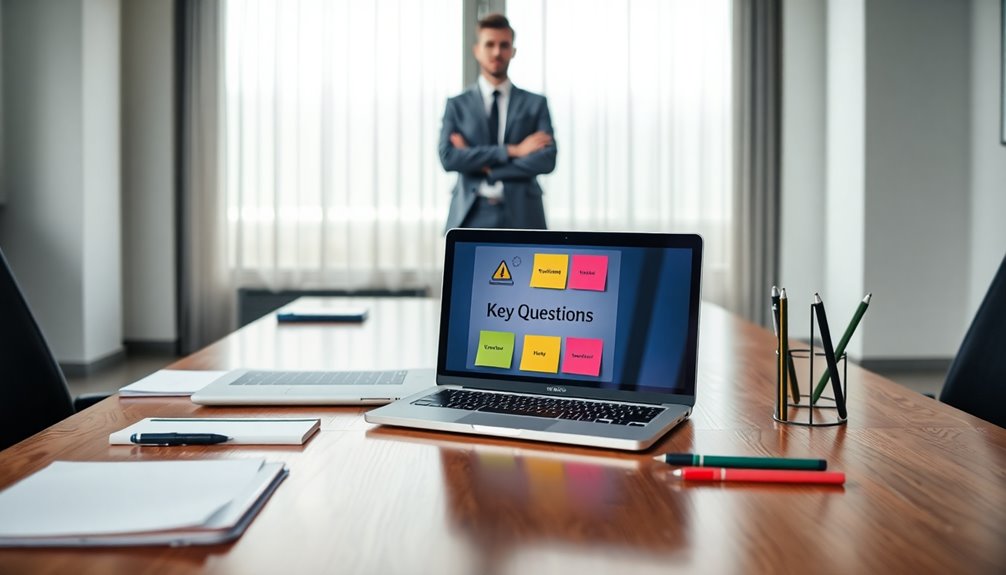Mastering project manager interviews means being prepared to answer key questions confidently. You'll want to address why you want to work at the company and what makes you unique. Be ready to discuss your experience and how you handle challenges. Show that you understand the importance of stakeholder management and highlight your success metrics. Effective communication, body language, and follow-up can truly set you apart. Engaging and recalling topics from the interview demonstrates your attentiveness and interest. There's a lot more to explore in mastering the art of interviews, so keep going to uncover valuable insights.
Key Takeaways
- Prepare for common questions like "What is your approach to team management?" to showcase your leadership style and experience.
- Familiarize yourself with the company's values and projects to demonstrate genuine interest during the interview.
- Use specific examples of successful project outcomes and metrics to illustrate your ability to deliver results.
- Practice effective communication techniques, such as maintaining eye contact and a positive posture, to convey confidence.
- Craft a thoughtful follow-up email that references key topics from the interview to reinforce your interest and professionalism.
Importance of Interview Preparation

Preparation is essential for acing project manager interviews. When you take the time to prepare, you boost your confidence and greatly enhance your performance.
Familiarize yourself with common interview questions and practice your responses. This helps you articulate your thoughts clearly and effectively. It’s also important to understand the underlying motivations behind these questions so that you can tailor your responses accordingly. By mastering common interview questions, you’ll feel more confident and prepared when it comes time for the actual interview. Additionally, practicing your responses will help you improve your communication skills and boost your overall performance during the interview.
Also, research the company and its projects—show that you're genuinely interested. Anticipate questions about your past experiences and be ready to discuss how you've tackled challenges in previous roles.
Remember that follow-up actions matter; sending a thank-you email can leave a lasting impression.
By preparing thoroughly, you position yourself as a strong candidate, demonstrating both your competence and commitment to the role. Additionally, understanding how automation technologies can impact project management may give you an edge in discussions about efficiency improvements.
Don't underestimate the power of preparation in this competitive field!
Body Language and Communication

Body language and communication play a pivotal role in project manager interviews. Your posture matters, so keep your head up and shoulders back to exude confidence.
Maintain eye contact with everyone you meet; it shows engagement and interest. Avoid fidgeting or tapping your fingers, as these can signal nervousness. Subtly mirroring the interviewer's posture can help create a connection.
If you feel anxious, practice deep breathing to calm your nerves before the interview. Taking a moment to think before answering is perfectly acceptable and demonstrates thoughtfulness.
Focus on the conversation and your responses, rather than your anxiety. Effective communication and positive body language will leave a strong impression and can greatly enhance your chances of success. Additionally, demonstrating a commitment to software quality assurance can highlight your dedication to delivering reliable projects.
Common Interview Questions

After establishing a positive rapport through effective body language and communication, you'll face the interview questions that can determine your fit for the role. Common questions often focus on your motivations and experiences. You should anticipate these to prepare effectively. Here's a quick reference table of typical questions you might encounter:
| Question | Purpose |
|---|---|
| Why do you want to work here? | Assess your motivation and alignment with values. |
| What makes you unique? | Gauge your self-awareness and individuality. |
| Describe your experience in this role. | Evaluate relevant skills and background. |
| How do you handle unexpected challenges? | Understand your problem-solving approach. |
| What is your approach to team management? | Insight into your leadership style and strategies. |
Be ready to answer these thoughtfully!
Responding to Experience Questions

When responding to experience questions, it's essential to showcase your journey in project management with clarity and confidence.
Start by discussing your initial interest in the field, then highlight specific projects you've managed, focusing on their scope and budget.
Be prepared to address significant challenges you faced and the innovative solutions you implemented.
Share your experiences with stakeholder management, emphasizing how you've engaged and communicated with them effectively.
If applicable, mention your experience managing remote teams, detailing how you maintained collaboration and productivity.
Metrics of Success

Understanding the metrics of success in project management is essential for demonstrating your effectiveness and value to potential employers. You should define success metrics clearly, using quantifiable data to measure outcomes.
Discuss how your projects align with organizational goals and emphasize stakeholder satisfaction. Share specific examples of successful project outcomes, highlighting the metrics you used to evaluate them.
Additionally, explain your methods for evaluating team performance, focusing on individual contributions. Regularly provide constructive feedback to foster a culture of continuous improvement. Incorporating data-driven decision-making into your project evaluations can significantly enhance the effectiveness of your metrics.
Stakeholder Management Techniques

Effective stakeholder management techniques are essential for project success. You need to engage and communicate effectively with stakeholders to guarantee their needs are met.
Here are some key techniques to take into account:
- Keep stakeholders informed: Regular updates help build trust and transparency.
- Balance conflicting priorities: Understand and negotiate between differing stakeholder needs to find a workable solution.
- Involve stakeholders in decision-making: Encourage their input to foster a sense of ownership and commitment to the project.
- Address concerns promptly: Be proactive in responding to feedback and addressing issues before they escalate.
Effective Risk Management

Risk management plays an essential role in the success of any project. You need to identify potential risks early and assess their likelihood and impact.
Create mitigation strategies to address these risks, ensuring you have a plan in place before issues arise. Monitoring risks continuously throughout the project is vital; stay alert to new threats that might emerge.
Communicating your risk management plans to stakeholders keeps everyone informed and aligned. Adjust your strategies as necessary based on project changes or unforeseen circumstances.
Learning from past experiences helps you refine your approach, making you more adept at handling risks in future projects.
Ultimately, effective risk management not only safeguards your project but also builds trust with your team and stakeholders.
Change Management Strategies

Steering through change in projects can be challenging, but having robust change management strategies in place makes all the difference.
To navigate these shifts effectively, you should consider these four key strategies:
- Communicate Clearly: Keep all stakeholders informed about changes and their implications.
- Assess Impact: Evaluate how changes affect timelines, budgets, and resources to make informed decisions.
- Document Processes: Record change management procedures for accountability and future reference.
- Engage Stakeholders: Involve stakeholders in discussions about changes to foster buy-in and minimize resistance.
Team Dynamics and Conflict Resolution

Steering change often uncovers underlying team dynamics that can either propel a project forward or create significant challenges.
As a project manager, you need to recognize signs of conflict early. Active listening is vital; it helps you understand each team member's perspective.
Facilitate open discussions to address conflicts and encourage collaboration. Emphasize compromise, allowing team members to feel heard and valued.
Document your conflict resolution processes for future reference, ensuring a clear path for addressing similar issues down the line.
Remember, open communication is essential in resolving conflicts; it fosters trust and strengthens team cohesion.
Follow-Up and Building Trust

Effective follow-up after interviews is essential for establishing trust and demonstrating your genuine interest in the position. A well-crafted follow-up can make you stand out from other candidates. Here's how to do it effectively:
- Send a thank-you email within 24 hours to express your gratitude for the opportunity.
- Reference specific topics discussed during the interview to show you were engaged and attentive.
- Reinforce your interest in both the role and the organization, highlighting why you're a perfect fit.
- Leave a lasting impression by including a thoughtful question or insight that continues the conversation.
These steps not only strengthen your candidacy but also foster a sense of trust with your potential employer.
Frequently Asked Questions
What Project Management Tools Are You Most Proficient In?
In the world of project management, the right tools can be your compass.
You're most proficient in tools like MS Project for scheduling, Trello for task tracking, and JIRA for Agile workflows. Each tool helps you streamline processes and enhance team collaboration.
You also leverage Slack for communication and Google Workspace for document sharing. These tools not only keep projects on track but also foster a productive environment for your team.
How Do You Prioritize Tasks During a Project?
When you prioritize tasks during a project, start by evaluating urgency and impact.
You can use tools like a priority matrix to categorize tasks based on their importance.
Communicate with your team to understand dependencies and deadlines.
Regularly review and adjust priorities as the project evolves.
Describe Your Experience With Remote Project Teams
When you describe your experience with remote project teams, focus on how you fostered communication and collaboration despite the distance.
You've likely used tools like Zoom and Slack to keep everyone connected.
Share specific examples of how you managed time zones and guaranteed accountability.
Highlight any challenges you faced and how you adapted, creating a productive environment.
Emphasize your ability to build trust and maintain team morale through regular check-ins and feedback.
What Is Your Approach to Managing Project Budgets?
Managing project budgets is like steering a ship through choppy waters; you need to stay focused and adaptable.
You start by creating a detailed budget plan, outlining costs and resources. Regularly tracking expenses helps you identify any discrepancies early.
You communicate openly with stakeholders about any changes and adjust the budget as necessary. By fostering a culture of accountability, you guarantee everyone understands their role in maintaining financial discipline throughout the project.
How Do You Ensure Project Deliverables Meet Quality Standards?
To guarantee project deliverables meet quality standards, you establish clear quality benchmarks from the start.
You implement regular check-ins and reviews, using checklists to track adherence to these standards. Engaging stakeholders for feedback throughout the process keeps everyone aligned.
Additionally, you conduct thorough testing before final delivery, addressing any issues promptly.
Conclusion
In summary, mastering your project manager interview can feel like climbing Everest, but with the right preparation, you'll reach the summit of success. Embrace the importance of body language, anticipate common questions, and articulate your experiences with confidence. Remember, showcasing your skills in metrics, risk management, and team dynamics will set you apart from the competition. So gear up, prepare thoroughly, and you'll not just survive the interview—you'll conquer it!
Eugene brings a fresh, dynamic voice to our platform as one of our talented Writers. Specializing in research-driven content, he explores the latest findings in psychology and personal growth, translating them into actionable insights for our readers. Eugene’s work is fueled by a curiosity about what makes us tick and a desire to help others unlock their potential.










